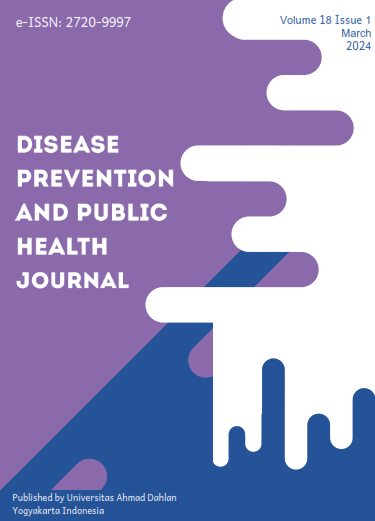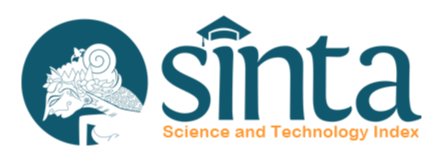Analysis of Health Belief Model in Adolescent Groups of Drug Users
DOI:
https://doi.org/10.12928/dpphj.v18i1.9282Keywords:
Drug users, Health belief model, Adolescents, Self treatmentAbstract
Background: The use of drugs (narcotics, psychotropics, and addictive substances) among adolescents in urban areas is increasing and is a concern for the benefit of public health, especially in an effort to maintain a healthy generation. This study aims to identify the health belief model in adolescent groups of drug users. Methods: This qualitative study employed a phenomenological design. The research focused on an unassisted drug user in Yogyakarta, who was not under the care of the National Narcotics Agency (NNA). Data was gathered through a Focus Group Discussion (FGD) involving six informants. Triangulation of information sources included the NNA and Drug Non-Governmental Organizations (NGOs). Data analysis was conducted using content analysis. Result: This study reveals that adolescents who use drugs tend to rely on self-treatment when seeking health services. They base their approach on assessing the symptoms and manageable effects of opium drugs, either individually or in groups. Their initial step involves consuming specific foods or beverages believed to counteract the drug's effects. This practice is influenced by advice from peers and information obtained from the Internet. Additionally, their reluctance to utilize healthcare facilities is reinforced by a fear of legal consequences. Conclusion: The health belief model in adolescent drug user groups in Yogyakarta is self-treatment. Thus, collaborative socialization and education efforts are needed between stakeholders (NNA, NGOs, Healthcare Facilities, and Schools). They should focus on enhancing awareness about the available health service programs for drug users, their types, and how to access them.
References
Hapsari PD, Putri AS, Kerstan H. Legal Policy for Drug Users in Indonesia and the Netherlands. J Creat Student. 2022;7(1):35–66. doi: https://doi.org/10.15294/jcs.v7i1.3620
Badan Narkotika Nasional. Indonesia Drugs Report. Vol. 5, Pusat Penelitian, Data, dan Informasi Badan Narkotika Nasional Republik Indonesia. 2021. p. 40–51.
Jazuli A, Haryono, Nugroho TWA, Firdaus I, Lukito I. Does Broken-Home Family Contribute to Drugs Abuse in Correctional the Most? Proc 1st Int Conf Law Hum Rights 2020 (ICLHR 2020). 2021;549(Iclhr 2020):91–7. doi: https://doi.org/10.2991/assehr.k.210506.014
Newcomb MD, Locke T. Health, Social, and Psychological Consequences of Drug Use and Abuse. Epidemiol Drug Abus. 2020;45–59. doi: https://doi.org/10.1007/0-387-24416-6_4
Aghaei AM, Gholami J, Sangchooli A, Rostam-Abadi Y, Olamazadeh S, Ardeshir M, et al. Prevalence of injecting drug use and HIV, hepatitis B, and hepatitis C in people who inject drugs in the Eastern Mediterranean region: a systematic review and meta-analysis. Lancet Glob Heal [Internet]. 2023;11(8):e1225–37. doi: http://dx.doi.org/10.1016/S2214-109X(23)00267-X
Saefudin Y, Hartiwiningsih, Isharyanto. Rehabilitation policy for drugs abuse in Indonesia. Indian J Forensic Med Toxicol. 2020;14(4):4111–5. doi: https://doi.org/10.37506/ijfmt.v14i4.12285
Hendra R, Narcotics N, Metro A. Harmonization of Rehabilitation Service Standards for Drug Abuse’s Addicts and Victims according to the Regulations. Ius Poenale. 2021;2(2):87–102. doi: https://doi.org/10.25041/ip.v2i2.2216
WHO, UNODC. International Standars for the Treatment of Drug Use Disorders. 2020. 121–228 p. doi: ISBN 978-92-4-000219-7
Nawi AM, Ismail R, Ibrahim F, Hassan MR, Manaf MRA, Amit N, Ibrahim N, Shafurdin NS. Risk and protective factors of drug abuse among adolescents: a systematic review. BMC Public Health. 2021 Nov 13;21(1):2088. doi: 10.1186/s12889-021-11906-2. PMID: 34774013; PMCID: PMC8590764.
Yolanda K, B SK, Hapsari A. Literature Review: Predisposing, Enabling and Reinforcing Factors that Influence Community Open Defecation Behavior in Indonesia [Internet]. Proceedings of the International Conference on Sports Science and Health (ICSSH 2022). Atlantis Press International BV; 2022. 88–120 p. doi: http://dx.doi.org/10.2991/978-94-6463-072-5_11
Björnsson ES. Epidemiology, Predisposing Factors, and Outcomes of Drug-Induced Liver Injury. Clin Liver Dis [Internet]. 2020;24(1):1–10. doi: https://doi.org/10.1016/j.cld.2019.08.002
Garofoli M. Adolescent Substance Abuse. Prim Care Clin Off Pract [Internet]. 2023;47(2):383–94. doi: https://doi.org/10.1016/j.pop.2020.02.013
Guay MA, Cawi RD. Implementation of War on Drugs Program in One of the Municipalities of Ifugao Province. Humaniora. 2021;12(3):191–200. doi: https://doi.org/10.21512/humaniora.v12i3.7116
Younis NM. Efficacy of Health Beliefs Model-Based Intervention in Changing Substance Use Beliefs among Mosul University Students : A Randomized Controlled Trial. Rev Bionatura. 2022;7(2). doi: https://doi.org/10.21931/rb/2022.07.02.35
Harris MT, Laks J, Stahl N, Bagley SM, Saia K, Wechsberg WM. Gender Dynamics in Substance Use and Treatment: A Women’s Focused Approach. Med Clin N Am. 2022;106:219–34. doi: https://doi.org/10.1007/978-3-031-16459-0_18
Kacha-ochana A, Jones CM, Green JL, Dunphy C. Characteristics of Adults Aged ≥ 18 Years Evaluated for Substance Use and Treatment Planning — United States , 2019. 2022;71(23). doi: https://doi.org/10.15585/mmwr.mm7123a1
Fonseca F, Robles-martínez M, Tirado-muñoz J, Alías-ferri M. A Gender Perspective of Addictive Disorders. Curr Addict Rep. 2021;8:89–99. doi: https://doi.org/10.1007/s40429-021-00357-9
O’Rourke S, Whalley H, Janes S, MacSweeney N, Skrenes A, Crowson S, et al. The development of cognitive and emotional maturity in adolescents and its relevance in judicial contexts. Scottish Sentencing Counc. 2020. doi: https://www.scottishsentencingcouncil.org.uk/media/2044/20200219-ssc-cognitive-maturity-literature-review.pdf
Trucco EM. A Review of Psychosocial Factors Linked to Adolescent Substance Use. Pharmacol Biochem Behav. 2020;1–35. doi: https://doi.org/10.1016/j.pbb.2020.172969
Navaneetham P, Kanth B. Effects of Personal Relationships on Physical and Mental Health among Young Adults- A Scoping Review Abstract : Open Psychol J. 2022;15:1–22. doi: https://doi.org/10.2174/18743501-v15-e2208180
Honghao J, Po Y, Tianyu Y. The influence of adolescents ’ romantic relationship on individual development : Evidence from China. Int J Chinese Educ. 2021;10(5). doi: https://doi.org/10.1177/22125868211070036
Guedes S, Real V, Correia E, Real V, Monteiro AP, Douro A, et al. Cyber dating abuse : Sex , substance use and relationship length. Psicoperspectivas. 2022;21(2):1–12. doi: https://doi.org/10.1177/22125868211070036
Khadka S, Shrestha O, Koirala G, Acharya U, Adhikari G. Health seeking behavior and self-medication practice among undergraduate medical students of a teaching hospital: A cross-sectional study. Ann Med Surg [Internet]. 2022;78(April):103776. doi: https://doi.org/10.1016/j.amsu.2022.103776
Shek DTL, Zhu X, Dou D, Chai W. Influence of Family Factors on Substance Use in Early Adolescents : A Longitudinal Study in Hong Kong Influence of Family Factors on Substance Use in Early Adolescents : A Longitudinal Study in Hong Kong. J Psychoactive Drugs [Internet]. 2020;52(1):66–76. doi: https://doi.org/10.1080/02791072.2019.1707333
Sari MP, Ayunin EN, Setyowati YD. Determinants of Adolescents’ Desire to Quit Smoking in Indonesia: Data Analysis of the 2014 Global Youth Tobacco Survey. Dis Prev Public Heal J. 2022;16(2):85–92. Doi: https://doi.org/10.12928/dpphj.v16i2.4860
Nugraha B, Defi IR, Yolanda RP, Warliani M, Biben V, Jennie J, et al. Describing community-based rehabilitation services in indonesia by using the international classification of service organization in rehabilitation 2.0. J Rehabil Medis. 2021;53. doi: https://doi.org/10.2340/16501977-2804
United Nations Office on Drugs and Crime. School-based education for drug abuse prevention. 2022. doi: https://www.unodc.org/pdf/youthnet/handbook_school_english.pdf
Jusoh AJ, Handrianto C, Walid DA, Wahab S, Rasool S. Drug Prevention Education Programs in Schools in High-Risk Areas: Challenges for Primary School Teachers in Malaysia Ahmad Jazimin Jusoh*. Al Ibtida J Pendidik Guru MI. 2023;10(1):1–12. Doi: https://doi.org/10.24235/al.ibtida.snj.v10i1.12984
Widjaja G. The Importance Of Early Child Drug Education; Indonesian Regulatory The Importance Of Early Child Drug Education; Indonesian Regulatory Perspective. Adv Soc Sci Res J. 2021;7(8). doi: https://doi.org/10.14738/assrj.78.8907
Ariss T, Fairbairn CE. The Effect of Significant-Other Involvement in Treatment for Substance Use Disorders: A Meta-Analysis. J Consult Clin Psychol. 2021;88(6):526–40. doi: https://doi.org/10.1037/ccp0000495
Nelson LF, Weitzman ER, Levy S. Prevention of Substance Use Disorders. Med Clin NA [Internet]. 2023;106(1):153–68. doi: https://doi.org/10.1016/j.mcna.2021.08.005
Downloads
Published
Issue
Section
License
Copyright (c) 2024 Universitas Ahmad Dahlan

This work is licensed under a Creative Commons Attribution-ShareAlike 4.0 International License.
Authors transfer the copyright and grant the Disease Prevention and Public Health Journal right of first publication with the work simultaneously licensed under a Creative Commons Attribution License (CC BY-SA 4.0) that allows others to share (copy and redistribute the material in any medium or format) and adapt (remix, transform, and build upon the material) the work for any purpose, even commercially with an acknowledgement of the work's authorship and initial publication in Disease Prevention and Public Health Journal. Authors are able to enter into separate, additional contractual arrangements for the non-exclusive distribution of the journal's published version of the work (e.g., post it to an institutional repository or publish it in a book), with an acknowledgement of its initial publication in Disease Prevention and Public Health Journal. Authors are permitted and encouraged to post their work online (e.g., in institutional repositories or on their website) prior to and during the submission process, as it can lead to productive exchanges, as well as earlier and greater citation of published work (See The Effect of Open Access).

This work is licensed under a Creative Commons Attribution-ShareAlike 4.0 International License.







